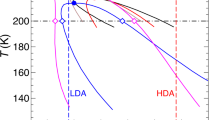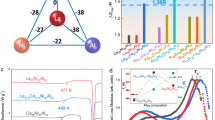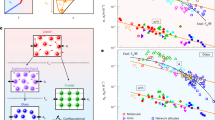Abstract
Arising from: Y.-Z. Yue & C. A. Angell Nature 427, 717–720 (2004); Yue & Angell reply.
It has been unclear whether amorphous glassy water heated to around 140–150 K remains glassy until it crystallizes or whether instead it turns into a supercooled and very viscous liquid. Yue and Angell1 compare the behaviour of glassy water under these conditions to that of hyperquenched inorganic glasses, and claim that water stays glassy as it heats up to its crystallization point; they also find a ‘hidden’ glass-to-liquid transition at about 169 K. Here we use differential scanning calorimetry (DSC) heating to show that hyperquenched water deposited at 140 K behaves as an ultraviscous liquid, the limiting structure of which depends on the cooling rate — as predicted by theoretical analysis of the liquid-to-glass transition2. Our findings are consistent with a glass-to-liquid transition-onset temperature (Tg) in the region of 136 K (refs 3,4), and they indicate that measurements of the liquid's properties may clarify the anomalous properties of supercooled water.
Similar content being viewed by others
Main
We hyperquenched micrometre-sized water droplets on a substrate held at 140 K (ref. 5) and immediately cooled it to 77 K at rates of 0.2, 2.0 and 5.0 K min−1. DSC scans recorded subsequently (Fig. 1) show that the height of the endothermic peak (ΔCp) decreases with increasing cooling rate. This effect disappears in DSC scans of samples that were prepared and cooled in the same manner but which were also annealed at 130 K (Fig. 1).
Top curves: effect of cooling rate of unannealed hyperquenched water samples, after deposition at 140 K for 16 min, on differential-scanning calorimetry (DSC) measurements recorded on subsequent heating at 30 K min−1; the cooling rate was increased from 0.2 K min−1 to 2.0 K min−1 and to 5.0 K min−1, and the corresponding scans are indicated by solid, dotted and dashed lines, respectively. Note the decrease in the height of the endothermic step with increasing cooling rate. Bottom curves: effect of annealing at 130 K for 90 min on hyperquenched water samples, after deposition at 140 K for 16 min and cooling at 0.2, 2.0 and 5.0 K min−1, on DSC scans recorded on subsequent heating at 30 K min−1 (line designations as in top curves). Note the disappearance of the effect of cooling rate for unannealed samples. Scans are normalized with respect to the weights and ice impurity of the samples and are drawn on the same scale. The ΔCp values are corrected for 22% ice impurity5. The ordinate scale is for 1 mg sample weight. The scans are superimposed at low temperatures.
The mean ΔCp (Tg) values of unannealed samples after cooling are: at 0.2 K min−1, 1.7±0.3 J K−1 mol−1 (135±1 K) (from 18 samples); at 2.0 K min−1, 1.1±0.2 J K−1 mol−1 (136±2 K) (from 9 samples); and at 5.0 K min−1, 0.7±0.1 J K−1 mol−1 (135±1 K) (from 9 samples). For Tg≈136 K, water relaxes during deposition at 140 K for 16 min, moving towards metastable equilibrium.
The limiting structure obtained on subsequent cooling may be characterized in terms of a limiting ‘fictive’ temperature (T′f), which decreases with decreasing cooling rate2. Decreasing T′f is experimentally observable by DSC on subsequent reheating, and is evident mainly as an increasingly pronounced overshoot2 (Fig. 1); an overshoot can also develop upon annealing below Tg (ref. 6).
The ΔCp increase of annealed samples4 (Fig. 1) contains an overshoot contribution, and water's ‘true’ ΔCp increase at Tg must be lower, approaching the value of about 0.7 J K−1 mol−1 obtained on cooling at 5.0 K min−1. A lower ΔCp value seems consistent with increasingly ‘strong’ behaviour of supercooled water7,8,9,10. Our findings therefore support the postulated fragile-to-strong transition of liquid water on cooling from ambient temperature into the supercooled and glassy state8,10.
Our results are not consistent with the sub-Tg or “shadow” peak postulated by Yue and Angell, because their criterion is that the onset temperature of the peak is the same as the annealing temperature (see Fig. 3b in ref. 1). This is not observed here because Tg does not vary with annealing temperature (Fig. 1).
References
Yue, Y. -Z. & Angell, C. A. Nature 427, 717–720 (2004).
Moynihan, C. T., Easteal, A. J., DeBolt, M. A. & Tucker, J. J. Am. Ceram. Soc. 59, 12–16 (1976).
Johari, G. P., Hallbrucker, A. & Mayer, E. Nature 330, 552–553 (1987).
Hallbrucker, A., Mayer, E. & Johari, G. P. Phil. Mag. B 60, 179–187 (1989).
Kohl, I., Mayer, E. & Hallbrucker, A. Phys. Chem. Chem. Phys. 2, 1579–1586 (2000).
Hodge, I. M. & Berens, A. R. Macromolecules 15, 762–770 (1982).
Angell, C. A. J. Non-Cryst. Solids 102, 205–221 (1988).
Ito, K., Moynihan, C. T. & Angell, C. A. Nature 398, 492–495 (1999).
Debenedetti, P. G. Metastable Liquids (Princeton Univ., New Jersey, 1996).
Starr, F. W., Angell, C. A. & Stanley, H. E. Physica A 323, 51–66 (2003).
Author information
Authors and Affiliations
Corresponding author
Rights and permissions
About this article
Cite this article
Kohl, I., Bachmann, L., Mayer, E. et al. Glass transition in hyperquenched water?. Nature 435, E1 (2005). https://doi.org/10.1038/nature03707
Published:
Issue Date:
DOI: https://doi.org/10.1038/nature03707
This article is cited by
-
Are volcanic melts less viscous than we thought? The case of Stromboli basalt
Contributions to Mineralogy and Petrology (2023)
-
Supercooled water confined in a metal-organic framework
Communications Physics (2020)
-
Glass transition in hyperquenched water? (reply)
Nature (2005)
Comments
By submitting a comment you agree to abide by our Terms and Community Guidelines. If you find something abusive or that does not comply with our terms or guidelines please flag it as inappropriate.




